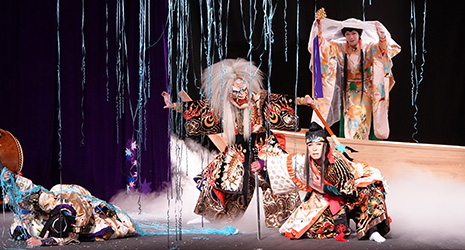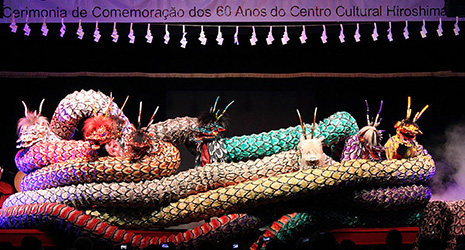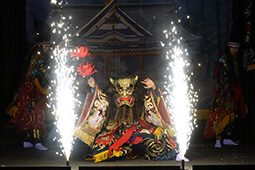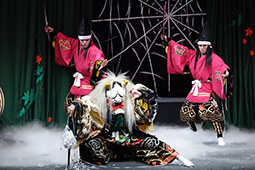April 2023
- English
- 日本語
Hiroshima Kagura: Plays for Today

Scene from Hashirimizu performed by Miyanoki Kaguradan 
Scene from Yamata no Orochi performed in Brazil

Scene from Itabukino-miya performed by Nakakawado Kaguradan 
Scene from Tsuchigumo performed by Kinsho Kaguradan

Hiroshima Kagura, a new form of kagura, an evolution of the local performance arts that have been passed down for hundreds of years, continues to captivate performers and audiences in Hiroshima and beyond.

Kagura is a performance art that has various traditions across Japan, but generally is considered to be a ceremony of thanksgiving to the gods who bestow a rich and peaceful life. The origins of present-day Hiroshima Kagura are said to lie in Geihoku Kagura, a form of folk entertainment that has been danced and passed down for over 250 years in the Geihoku region of northern Hiroshima Prefecture. Geihoku Kagura itself developed as a rustic autumnal festival celebrating the harvest. When bringing this form of kagura to the stage, stories from the Japanese classical performing arts of noh and kabuki were incorporated, and through the creative use of lighting and stage direction, Geihoku Kagura developed into a new form of kagura: Hiroshima Kagura. The most distinctive features of Hiroshima Kagura include the use of washi paper masks, colorful costumes and lively dancing.
There are more than 70 different plays associated with Hiroshima Kagura today. They are based primarily on myths and folktales from across Japan, and most of these have been adapted into easy-to-understand stories of right and wrong. For example, a famous tale is about the Yamata no Orochi, a large snake-like monster with eight heads and eight tails, that comes down from a large mountain to swallow a maiden before being vanquished by a deity. Several performers wear the huge, colorful costume of the snake and the performance is quite powerful. In another popular tale, a beautiful princess is transformed into a demon, which requires quick mask and costume changes by the performer. Musical accompaniment is provided by Japanese drums and flutes, and the entire audience erupts in applause at the end of the performance.
Kagura refers to songs and dances that are dedicated to the deities. Kagura as a religious act is considered to have been established in the 8th century, and in Japan where villages are formed around rice farming, harvest kagura were performed as prayers to express gratitude for an abundant grain harvest. The kagura passed down today in each of these villages is called satokagura (village kagura), but as the populations of rural areas have decreased along with modernization, there are many regions where satokagura has disappeared. Geihoku Kagura on the other hand took a dramatic new direction.

“The movements of Geihoku Kagura are intense and, as a cultural form, it has been sustained by young people. This engagement becomes a source of vitality for rural villages. So we thought that we should pass on this traditional culture creatively instead of merely preserving it,” says Hayashi Hideki, president of the NPO Hiroshima Kagura Art Laboratory.
In 1948, kagura groups based in the northern part of the prefecture gathered and a kagura competition was held, and since then, it has been held annually.
“Winning the competition becomes a source of pride for a region. All groups rehearse with passion and engage in friendly rivalry,” says Hayashi.
As these groups were becoming more active, a new form of kagura was tried out in a large hall in central Hiroshima in 1993, with exciting costumes, lighting and stage effects to defy conventional wisdom as a performing art. The direction proved to be a great success, and marked the birth of the new Hiroshima Kagura as a performing art.

The reputation of this new art form spread not only within Japan but abroad as well, and so far, it has been performed many times in China, Mexico, Brazil, France, and other countries. “Even with an interpreter, I wasn’t sure if non-Japanese people would understand, as kagura is an art form that developed from local Japanese customs. But it was very well-received in every country. People are particularly surprised when they are told that the performers are all amateurs,” says Hayashi.
There are currently around 200 kagura groups within Hiroshima Prefecture. Members include farmers, company employees, and youngsters, some of whom are so taken by Hiroshima Kagura that they travel more than an hour to attend practices.
Thanks to group members’ regular practice, performances can be enjoyed every Wednesday at the Hiroshima Prefectural Citizen’s Cultural Center in Hiroshima City. The plays are performed using a script that is easy even for first-time viewers to understand, so they move everyone, whether children, adults, or overseas tourists.
Kagura resonates with the hearts of its audience because it not only conveys local pride but also touches the soul.

